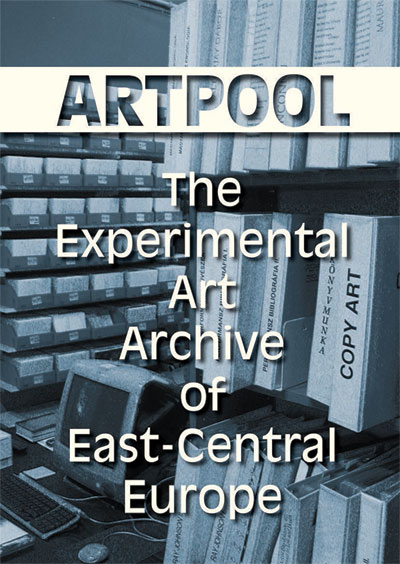György Galántai, Julia Klaniczay (eds.): Artpool: The Experimental Art Archive of East-Central Europe (2013)
Filed under book | Tags: · archive, art, art history, artists book, avant-garde, east-central europe, fluxus, mail art, performance, sound poetry, visual poetry

“How could an arts initiative, called Artpool, in the 1970s, in a small corner of the world, in East-Central Europe, become a significant node, a reference point in a worldwide – initially analogue (postal) then digital (online) – network?
How has it been able to validly speak out and address issues and people again and again in the ‘storms’ of history and scientific-technological progress, for more than four decades now?
Using authentic documents, numerous photographs and illustrations Artpool’s chronological volume containing a brief presentation of events and exhibitions, a detailed bibliography and references follows the history of the Artpool art project – launched more than forty years ago by fine artist György Galántai and later jointly realized with Júlia Klaniczay – from the exhibitions of the Chapel Studio active in Balatonboglár between 1970 and 1973, through the establishment of the Artpool archive in 1979 to the opening of the Artpool Art Research Center in Budapest in 1992 and its becoming an esteemed research facility by the 2010s.
Hundreds of artists from all corners of the world sent their works to the international Artpool exhibitions, which are built on the “Active Archive” concept and explore themes inspired by our perpetually changing world, in the same way as György Galántai and Artpool also participated in the events organized in the various other nodes of the “Eternal Network”.
The information accumulated in Artpool over the forty years, the collections that were built up, and the research work based on them form the tissue of today’s institute, which beyond the developments in the art scene also informs us about the eventful forty or so years during which Artpool came into being and has continued to operate. This period can be best described by the following keywords: communism, iron curtain, secret files, tapping telephone wires, bans, “the happiest barrack”, samizdat publications, counterculture, change of the system, democratic transition, freedom of the press and speech, independent non-profit initiatives, European Union, strengthening nationalism and conservatism; 20th century, millennium, 21st century; technological and communication explosion.”
Foreword by Kristine Stiles
Publisher Artpool, Budapest, 2013
ISBN 9630872250, 9789630872256
535 pages
PDF (50 MB, updated on 2019-10-29)
Flash
Emmett Williams (ed.): An Anthology of Concrete Poetry (1967/2013)
Filed under poetry | Tags: · concrete poetry, language, literature, poetry, visual poetry

“Concrete Poetry is not one style but a cluster of possibilities, all falling in the Intermedium between semantic poetry, calligraphic and typographic poetry, and sound poetry.
It first crystalized out of these earlier modes in the early 1950s in the works of such people as Eugen Gomringer (CH), Carlo Belloli (IT), Dieter Rot (IS), Öyvind Fahlström (SW), the Noigandres Group (Haroldo and Augusto de Campos, Décio Pignatari and others, BR), Carlfriedrich Claus (GDR), Gerhard Rühm, Friedrich Achleitner and H.C. Artmann (AT), Daniel Spoerri and Claus Bremer (DE), and Emmett Williams (US, then living in DE). In recent years a second generation of major figures have added to the movement, including such people as Hansjörg Mayer (DE), Ladislav Novák and Jiří Kolář (CZ), Edwin Morgan and Ian Hamilton Finlay (SC), Bob Cobbing (EN), bp Nichol (CA), Mary Ellen Solt and Jonathan Williams (US), Pierre and Ilse Garnier (FR), Seiichi Niikuni and Kitasono Katue (JP) and many others.
The very fact of the appearance of parallel work more or less independently in so many countries and languages indicates one of the unique aspects of the movement, namely its source being in the development of a new mentality in which values become fused and inter-relationships established on a more complex plain than was the case in the purer, earlier modes of poetry.” (Something Else Press, 1967)
Publisher Something Else Press, New York, 1967
New edition Primary Information, New York, 2013
ISBN 9780985136437
x+342 pages
via Silvio Lorusso
Reviews: Ingrid Melano (Kaleidoscope 2014), Sam Rowe (Chicago Review 2014).
PDF (91 MB)
Comment (1)Aleksandar Bošković: Photopoetry and the Bioscopic Book: Russian and Czech Avant-Garde Experiments of the 1920s (2013)
Filed under thesis | Tags: · art, art history, avant-garde, book, constructivism, montage, photomontage, poetry, technology, typography, visual poetry

The extraordinary junction between poetry, photography and photomontage — photopoetry — flourished in avant-garde books and journals throughout Europe in the 1920s and 1930s. The new genre aspired to appropriate the products of technological culture in creating poetry more alert to the mass sensibility of a rapidly changing mechanical age. As a new hybrid form that combines poetic text and photographic images, it was ripe for poetic experimentation and production of optical provocations.
This dissertation focuses on three avant-garde photo-poetry books — Mayakovsky and Rodchenko’s About This (1923), Nezval and Teige’s Alphabet (1926), and Mayakovsky and Rozhkov’s unpublished and little known To the Workers of Kursk (1924-7) — examining them from the angle of the bioscopic book, a concept envisaged in a programmatic manner by El Lissitzky in 1923. (from the Abstract)
Dissertation
Slavic Languages and Literatures, University of Michigan, 2013
309 pages
PDF, PDF (9 MB, updated on 2020-7-23)
See also Mayakovsky and Rozhkov’s book in PDF (3 MB, via vk.com). Commentary: Bošković (2017).
Comment (0)
